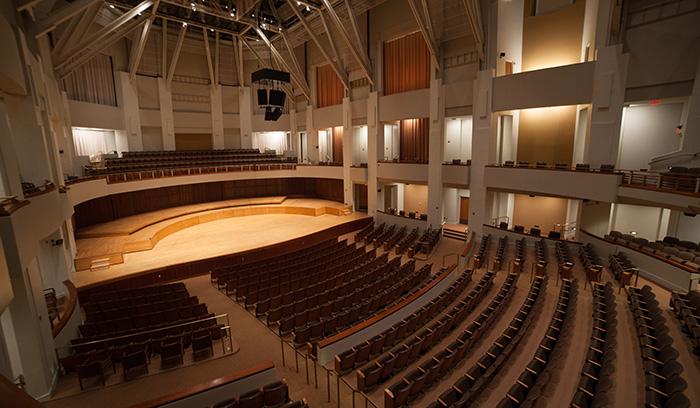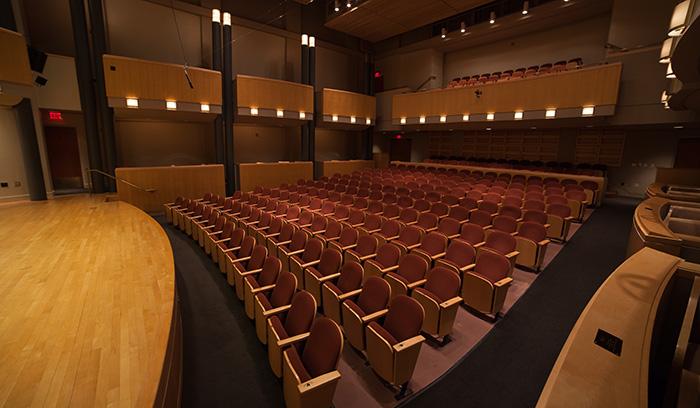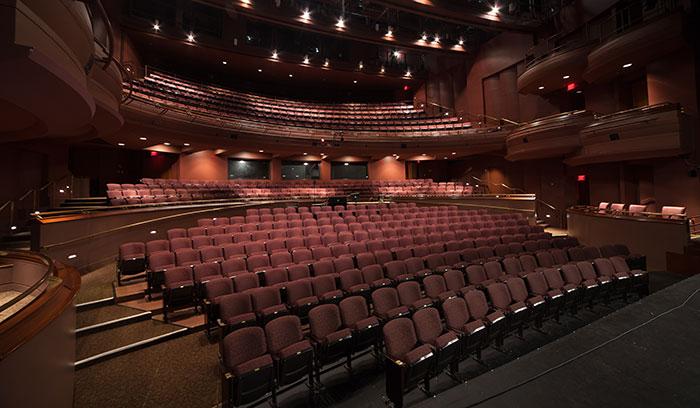FACILITIES
The Clarice Smith Performing Arts Center is home to the University of Maryland School of Music. Built on a 17-acre site as a hub for outstanding instruction, performance and research, the 318,000 square-foot complex brings together three academic units, a professional presenting organization and a vast performing arts library to form one of the largest and most advanced university arts centers in the country.
Classrooms & Rehearsal Rooms
Here at The Clarice Smith Performing Arts Center, music students enjoy a strong sense of community in a modern, specialized facility that suits their unique educational needs while fostering collaboration, creativity and growth.
Our classrooms and rehearsal rooms all include full audio/video capabilities. Our faculty studios and practice rooms are equipped with 100+ well-maintained Steinway pianos.
Leah M. Smith Lecture Hall
This hall is an intimate venue with seating for up to 90 guests, featuring a built-in projector and retractable screen. From music theory lectures to recital performances, this hall serves as a space where big ideas and experiences can be shared in a small group environment.
Music Technology Lab
- The Music Technology Lab (Room 1108) is designed for the study and practice of applications in music technology.
- The lab is equipped with 18 student workstations and an instructor workstation with overhead projection, JBL speakers and Bluetooth audio capability. Each workstation in the lab includes an Apple Macintosh iMac with 27" monitor, 8 GB ram and 1TB Fusion hard drive and a Korg Triton Pro keyboard with Finale, Sibelius, Logic, GarageBand and Reason software installed. Each computer in the lab includes a Scarlett Solo audio interface.
- All computers are connected to the internet and professional quality printing (including oversize printing on an HP 5200 printer) through a high-speed Ethernet connection.
Computer Music Studio
- The Computer Music Studio (Room 1110G) is specifically designed for composers and researchers using digital sound applications.
- Computer workstation: Apple Macintosh iMac with 27" monitor, 8 GB ram and 1TB Fusion hard drive and Mackie Onyx 1620i Mixer/Audio interface.
- Monitors: Mackie Dynaudio BM6A Reference Monitors.
- Synthesizers, Signal Processors and MIDI Interface: Kurzweil K2600XS (128 Mb Sample RAM), Orchestra and Contemporary ROM, Kurzweil K2500 Rack Mount, Korg Trinity TR Rack Mount, TC Electronics M-One Digital Signal Processor and Mark of the Unicorn MIDI Express MIDI Patch Bay.
- MIDI Controllers: Nektar Impact LX49+, Roland SPD Percussion Sampling Pad.
- Microphones: Shure, AKG, Audio Technica.
- Software: Finale, Sibelius, Logic, GarageBand and Reason.
Ethnomusicology & Musicology Technology Lab
The Ethnomusicology & Musicology Technology Lab (Room 3112) is for ethnomusicological and musicological research, publication and media production. It is equipped with portable audio and video recording devices, a complete post-production audio and video hardware suite and four computer workstations for student and faculty use.
The lab's post-production studio environment can handle most world audio and video formats. The computer workstations include a dual quad-core Intel Macintosh, a second Macintosh, a Windows workstation and a Linux workstation. The workstations use a cross-platform core of powerful open-source audio, video and image-processing software, and additional platform-specific industry-standard software. All workstations also include score-editing software. The lab provides tools for students and faculty to create CDs, DVDs, websites, presentations, research papers and scores.
Music Education Resource Center
Arundel Mills Piano Lab
Historical Keyboards Room
Seminar Rooms
- Mary & Kingdon Gould, Jr. Music Seminar Room
- Musicology & Ethnomusicology Seminar Rooms
Chamber Rooms
- Doris & Nathan Patz Ensemble Room
- Leslie & Leonard Shapiro Chamber Ensemble Rehearsal Room
- J. Spencer & Ruth S. Overholser Ensemble Room
- Jazz Ensemble Rehearsal Room
Specialized Ensemble Room
- Orchestra/Jazz Rehearsal Room
- Opera Rehearsal Room
- Opera Classroom
- Chorus Rehearsal Room
- John E. Wakefield Band Room
Performance Venues
The Clarice houses six state-of-the-art and stunningly beautiful venues, three of which are used extensively by music students and ensembles:
Dekelboum Concert Hall
The Dekelboum Concert Hall is the grand performance home for the School of Music’s large ensembles including the UMD Symphony Orchestra, UMD Wind Orchestra, UMD Wind Ensemble and UMD Repertoire Orchestra. Featuring 970 seats, the beautiful and functional architectural design of the hall augments the big, sweeping sounds of large ensembles while providing an unobstructed view of the stage with a riser system that allows all members of performing ensembles to be visible to the audience. Adjustable acoustical curtains help ensure ideal sound quality for performances and recordings.
Gildenhorn Recital Hall
The Gildenhorn Recital Hall is a visual and acoustical beauty for small ensembles, chamber groups, opera scenes and student and faculty recitalists. Referred to by the architect as the “jewel box” of The Clarice, the Gildenhorn Recital Hall is an intimate space with bright acoustics. Featuring 297 seats, it offers a warm and inviting setting for solo and chamber artists. An adjustable acoustical curtain helps ensure ideal sound quality for performance and recordings.
Kay Theatre
The Kay Theatre is a classic proscenium theatre housing 626 seats that combines the atmosphere of an “Old Broadway” house with the amenities of a state-of-the-art performance venue. With a massive fly system, theatrical lighting, expansive wing space and an adjacent scene shop, this theatre is home to the full productions of the Maryland Opera Studio and is favored by jazz big bands and large world music ensembles.
Additional Performance Venues
In addition to these three venues used extensively by the School of Music, the Kogod Theatre, Dance Theatre and Cafritz Foundation Theatre are used for cross-disciplinary projects and special events involving music students and faculty. The Ulrich Recital Hall located in the nearby Tawes Building, former home of the School of Music, is also available for student recitals and music classes.
Streaming Policy
Each year, The Clarice Smith Performing Arts Center features hundreds of performances by faculty, students and visiting artists. It is now possible to experience some of these performances regardless of your physical or geographical location through new streaming technology. Streaming a performance also allows it to be recorded and preserved indefinitely. We are excited to be able to utilize this technology to enhance the university’s ability to share exceptional work with the campus, community and the world.
If you are interested in experiencing one of our publicly streamed events, a list of upcoming opportunities can be found at vimeo.com/theclarice. Please review the Streaming Policy.
Performing Arts at Maryland Partners & Resources
Michelle Smith Performing Arts Library
The Michelle Smith Performing Arts Library (MSPAL) carries more than 300,000 holdings/recordings, including the renowned International Piano Archives at Maryland. Its location inside The Clarice is a valuable asset and rare convenience for students by being a specialized library located in the same building as the School of Music.
MSPAL is the central location on the College Park campus for music, theater and dance materials. MSPAL's circulating, reference, serial and special collections combine to make it one of the country's most comprehensive university libraries of its kind. Opened in 2000 as part of The Clarice Smith Performing Arts Center, MSPAL's public spaces include a spacious main reading room, a separate reading room for special collections, a lounge-style study room, a seminar room and a group study room. A multimedia exhibition gallery, with an adjacent lecture/concert room, links the library to The Clarice's exciting programming via the Grand Pavilion.
Throughout MSPAL patrons find a variety of comfortable spaces for reading, listening, viewing and studying. Individual carrels with computer workstations provide access to the UMD Libraries' full complement of electronic resources and feature an excellent remote audio/video delivery system.
Reference librarians, curators and expert permanent staff are available on weekdays during regular working hours. However, the library is open evening and weekend hours, and offers basic circulation and information services during those times.
MSPAL is particularly well known for its special collections; over a mile of manuscripts, letters, sound recordings, programs, scrapbooks, photographs and other archival materials comprise some of the primary source materials available in the library. Various publications and recordings based on the collections are produced by the library and distributed internationally. The library also sponsors symposia, exhibitions and other special events throughout the year.
International Piano Archives at Maryland
The International Piano Archives at Maryland (IPAM) is a unique resource for the study, appreciation and preservation of the classical piano repertoire and its performance. IPAM's collections comprise one of the world's most extensive concentrations of piano recordings, books, scores, programs and related materials, including the archival papers of many great keyboard artists.
IPAM was founded in Cleveland, Ohio, in 1965 by Albert Petrak and Gregor Benko, who soon moved the organization to New York City where they added William Santaella to the staff. In New York, the archives quickly grew into an audio treasure and earned acclaim for its reissues of historic piano performances. In 1977, IPAM was given to the University of Maryland, College Park, where it serves students and faculty, as well as an international community of musicians, researchers and friends of piano performance.
From 1980 to 1994, under the leadership of Neil Ratliff, IPAM's collections increased and diversified, and the reissues of historic piano performances continued. Ratliff also initiated the publication of books and a newsletter, as well as a program of public events and exhibitions. IPAM's first curator, Morgan Cundiff, was succeeded in 1993 by Donald Manildi.
School of Theatre, Dance, and Performance Studies
The School of Theatre, Dance, and Performance Studies (TDPS) also resides within The Clarice Smith Performing Arts Center. Its close proximity to the School of Music fosters collaboration between the two schools and makes cross-disciplinary projects more feasible. Theatre and dance performances frequently include contributions from the School of Music and Maryland Opera Studio performances in collaboration with TDPS.
Theatre productions are staged in three venues: the proscenium Kay Theatre, the versatile Kogod Theatre and the experimental Cafritz Foundation Theatre. Dance productions are staged primarily in the specialized Dance Theatre.




